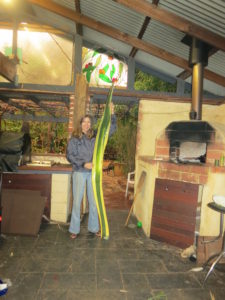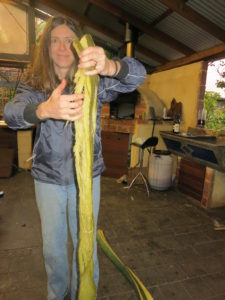We just recently spent a delightful rainy Sunday afternoon in the garden, drinking wine and roasting potatoes in ‘Ned Kelly’… the old school fire pit at Barb’s. There may also have been chocolate <ahem…>
In the video below Barb takes us through the old way of making your own twine or cordage. This technique can be applied to almost any fiber that you have available…. and it really is very easy.
You could totally make one of these

Or even, for the hardcore babywearer…

(As a side note, there are heaps of babywearing groups in your local area, check on Facebook and attend a meeting to get trained in safety and borrow wraps and buckles to see which style you prefer)
In the case of agave, it is an excellent choice for finger rolling cordage because it grows well in this climate with zero inputs and can be easily harvested by slicing off a rather tall leaf and boiling for an hour or more.


After this, it just needs pounding to remove the juices and leave the fiber… then finger rolling.
This is using two sets of fibers, twisting both independently, then twisting the two together. The knack would seem to be in remembering to twist the sets of fibers one way but then the two together must be in the opposite direction. …good thing that there is a video lol…


